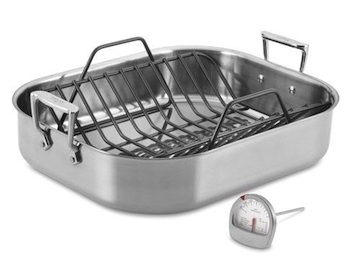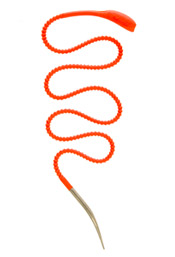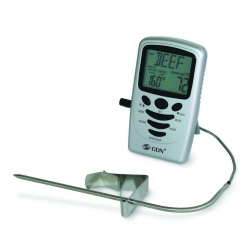
The menu has been planned, the shopping is complete, and now it is time to get cooking. Whether it is a turkey, a beef roast, leg of lamb or a delicious glazed ham, having the proper roasting equipment on hand will make the process go much more smoothly. And, the results will so much more enjoyable!
Roasting Pans
 Trade in the grocery store disposable roasting pan for a good quality-roasting pan that will perform for years to come. Roasting pans are made of different materials, most are effective at what they do. Keep in mind that some nonstick coatings can prevent the roast from browning. A roasting pan must be sturdy enough to handle the weight of a roast, and have handles that allow for easy maneuvering (even with oven mitts on). Choose an appropriate sized pan for what you’ll be roasting. Generally there should be about 2” of space between the meat and sides, and 2” between the pan and the oven walls. You may need a smaller pot or pan for pork tenderloins, for example. A roasting pan should be about 2 inches deep, low enough so the hot air can circulate around the roast.
Trade in the grocery store disposable roasting pan for a good quality-roasting pan that will perform for years to come. Roasting pans are made of different materials, most are effective at what they do. Keep in mind that some nonstick coatings can prevent the roast from browning. A roasting pan must be sturdy enough to handle the weight of a roast, and have handles that allow for easy maneuvering (even with oven mitts on). Choose an appropriate sized pan for what you’ll be roasting. Generally there should be about 2” of space between the meat and sides, and 2” between the pan and the oven walls. You may need a smaller pot or pan for pork tenderloins, for example. A roasting pan should be about 2 inches deep, low enough so the hot air can circulate around the roast.
Roasting Racks
If you are of the school that believes roasting requires that air circulate around the food for proper browning, then a roasting rack, or a spit, is needed. They sit in the pan and hold the meat away from the bottom of the pan, allowing the air to circulate and the fat to drip away. Make sure the rack is well constructed and sturdy enough to hold the meat. It should allow for at least 2” clearance from the top of the oven. Roasting racks come in different styles: V rack (adjustable or non-adjustable), flat rack, vertical poultry roasters, and a basket rack.
Lifters
Have you ever grabbed a long wooden spoon, placed it into the tail end, balanced the bird with a spoon on the other end, and then carefully transferred the turkey from roaster to carving platter? Not an easy task. One great way to move the bird (or roast) from pan to platter is to use a turkey lifter. They come in different styles – a cradle, a hook, and a set of forks (which are used to pierce the skin). This holiday season, don’t opt for the oven mitt transfer, get yourself an ‘official’ turkey lifter.
Baster
 Bulb basters get their most use during Thanksgiving, but they’re great for use all year round for so many different types of roasts. Acting like a big eyedropper, they suction up the fat and liquid from the roasting pan and pour them over the meat to keep it moist while adding flavor and creating a glaze during cooking time. Some basters come equipped with an attachable needle that can be screwed into the top and used for injecting the juices into the meat. Alternately, you can use a basting brush.
Bulb basters get their most use during Thanksgiving, but they’re great for use all year round for so many different types of roasts. Acting like a big eyedropper, they suction up the fat and liquid from the roasting pan and pour them over the meat to keep it moist while adding flavor and creating a glaze during cooking time. Some basters come equipped with an attachable needle that can be screwed into the top and used for injecting the juices into the meat. Alternately, you can use a basting brush.
Trussing String
We all feel compelled to truss, but do we really know why? Trussing the roast into a more uniform shape helps to ensure even cooking. And trussing a turkey into a compact shape helps it cook evenly, and when the twine is removed, the turkey will still hold its shape for easier carving. Get some kitchen twine, or reusable silicone trussing tools, and get tying.
why? Trussing the roast into a more uniform shape helps to ensure even cooking. And trussing a turkey into a compact shape helps it cook evenly, and when the twine is removed, the turkey will still hold its shape for easier carving. Get some kitchen twine, or reusable silicone trussing tools, and get tying.
Thermometer
 The success of your efforts in the kitchen depends on the food reaching and maintaining the proper temperature. Finger poking isn’t always the best way to determine if a meat is properly cooked, so an instant-read thermometer is perfect for all your roasting needs, and a digital version, with its small sensors located in the tip, are extremely accurate at measuring a wide range of temperatures.
The success of your efforts in the kitchen depends on the food reaching and maintaining the proper temperature. Finger poking isn’t always the best way to determine if a meat is properly cooked, so an instant-read thermometer is perfect for all your roasting needs, and a digital version, with its small sensors located in the tip, are extremely accurate at measuring a wide range of temperatures.
Slicing/Carving Knife
While we use slicing and carving interchangeably, carving is what is typically done at the table and requires a thin, barely flexible blade. The more rigid knives are used for hot and juice meats (think roast beef), while more flexible knives are used for poultry. A carving/slicing knife with a long thin or pointed blade requires skill in order to obtain an even cut. The broader rounded tip slicer is easier to use. A 10” length is good — too long of a blade and your cuts will become uneven.





